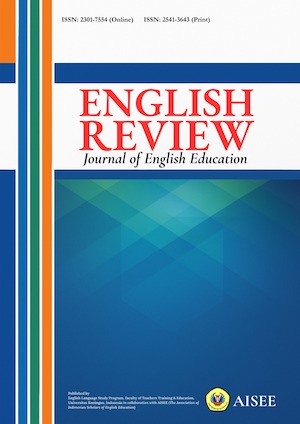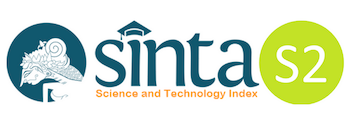ENHANCING ESP TEACHING FOR COMPUTER AND NETWORK ENGINEERING STUDENTS THROUGH MULTIMEDIA
Abstract
This article discusses the application of short videos and pictures in teaching ESP procedure texts in computer and network engineering majors. This research uses a qualitative method with a case study design to explore the integration of video and pictures in ESP teaching, the challenges teachers face in integrating videos and pictures in ESP teaching, and how teachers overcome these challenges. The participants of this study consisted of one English teacher in computer and network engineering class who was selected by purposive sampling. The research was conducted at SMK Mahardika Malang and involved English teachers from the computer and network engineering department. Data collection methods included observation and interviews with teachers, focusing on the procedures for integrating short videos and pictures, the challenges faced, and solutions to overcome these challenges. The findings reveal that there are several activities in the classroom, namely teacher activities, student activities, and the learning and teaching process. Teachers face three challenges. The first is time constraints. To overcome this challenge, teachers must use pictures and short videos wisely and adjust them to the time available in the lesson plan. The second is the mismatch of learning material sources. The solution to this challenge is to use effective multimedia such as the Internet and YouTube. The third is students' low motivation to learn English and write procedural texts. The solution to this challenge is for teachers to approach students emotionally, consult with their parents, and provide project-based learning strategies using English. This research provides valuable insights for ESP education, emphasizing the importance of adapting content to industry needs, addressing motivation issues, and effectively using multimedia elements.
References
Ain, R. Q., Nawir, A., Andi, M., Ardiana, & Suwarni. (2023). Pictionary game: Its effect to upgrade ESP students’ vocabulary mastery at SMK Negeri 2 Pangkep. Eltin Journal: Journal of English Language Teaching in Indonesia, 11(1). https://doi.org/https://ejournal.stkipsiliwangi.ac.id/index.php/eltin/article/view/3485
Al Baekani, A. K., Hapsari, N., & Muslihat, A. (2023). Engaging students in a flipped classroom instruction: Teaching English for Specific Purpose (ESP) in higher education. English Review: Journ al of English Education, 11(3). https://doi.org/10.25134/erjee.v11i3.7845
Aminah, S., Sunan, U., & Surabaya, A. (2018). The use of video in teaching writing on procedure text. NOBEL: Journal of Literature and Language Teaching, 9(2).
Azizah Ria Kusrini, N., & Rizki Amalia, E. (2021). The influence of integration of four skills to the performance of undergraduate students on TOEFL sample test. SCHOLASTICA: Jurnal Pendidikan Dan Kebudayaan, 3(1), 61–74.
Chaovanapricha, K., & Chaturongakul, P. (2020). Interdisciplinary teacher collaboration in English for Specific Purposes subjects in a Thai University. English Language Teaching, 13(5), 139. https://doi.org/https://doi.org/10.5539/elt.v13n5p139
Fay, A. D. A., & Matias, J. (2019). Teaching English through Youtube: Grammar video analysis of three brazilian youtube channels dedicated to EFL teaching. English Review: Journal of English Education, 8(1), 1. https://doi.org/10.25134/erjee.v8i1.2351
Fu, M., & Li, S. (2022). The effects of immediate and delayed corrective feedback on l2 development. Studies in Second Language Acquisition, 44(1), 2–34. https://doi.org/10.1017/S0272263120000388
Işik-Taş, E. E., Kenny, N., & Jian, H. (2019). English for Specific Purposes instruction and research: Current practices, challenges and innovations. In English for Specific Purposes Instruction and Research: Current Practices, Challenges and Innovations. Springer International Publishing. https://doi.org/10.1007/978-3-030-32914-3
Aminah, S., Sunan, U., & Surabaya, A. (2018). The use of video in teaching writing on procedure text. NOBEL: Journal of Literature and Language Teaching, 9(2).
Khalil, L., & Kholofelo Semono-Eke, B. (2020). Appropriate teaching methods for general English and English for Specific Purposes from teachers’ perspectives. Arab World English Journal, 11(1), 253–269. https://doi.org/https://doi.org/10.24093/awej/vol11no1.19
Khaliq, A., & Nasution, R. (2019). YouTube as a media in English Language Teaching (ELT) context: Teaching procedure text. Journal Unilak, 1(1).
Kováčiková, E. (2020). English for Specific Purposes in higher education through content and language integrated learning.
Miles, M. B., Huberman, A. M., & Saldaña, J. (2014). Qualitative data analysis_ a methods sourcebook (H. Salmon, K. Perry, & K. Koscielak, Eds.; Third). SAGE Publications.
Moreno, A. I., & Escobar, M. Á. (2021). On the use of video description in an online collaborative writing project with ESP learners of tourism studies. Language Teaching Research Quarterly, 23, 46–63. https://doi.org/10.32038/ltrq.2021.23.05
Nuraini, S. A., Sudiran, S., & Hartono, H. (2023). Enhancing speaking skills of non-English major students: Evaluating the impact of sociodramatic games. VELES (Voices of English Language Education Society), 7(3), 765–774. https://doi.org/10.29408/veles.v7i3.24461
Papadima-Sophocleous, S. , Kakoulli Constantinou, E., & Giannikas, C. N. (2019). ESP teaching and teacher education: current theories and practices. ESP Teaching and Teacher Education: Current Theories and Practices.
Radosavlevikj, N., & Hajrullai, H. (2019). Using video presentations in ESP Classes (a study conducted at the Language Centre-Skopje, SEEU). SEEU Review, 14(1), 178–195. https://doi.org/10.2478/seeur-2019-0010
Rohani, S., & Suyono, A. (2021). Developing an Android based bilingual e-glossary application of English for Specific Purposes (ESP). English Language Teaching Educational Journal, 4(3), 225–234. https://doi.org/https://doi.org/10.12928/eltej.v4i3.5209
Saienko, N., Semyda, O., & Akhmad, I. (2020). Using social networks in teaching Esp to engineering students. Advanced Education, 7(14), 38–45. https://doi.org/https://doi.org/10.20535/2410-8286.198083
Santos Espino, J. M., Afonso Suárez, M. D., & González-Henríquez, J. J. (2020). Video for teaching: classroom use, instructor self-production and teachers’ preferences in presentation format. Technology, Pedagogy and Education, 29(2), 147–162. https://doi.org/10.1080/1475939X.2020.1726805
Sari, L. I. (2022). Teaching online esp during covid-19 pandemic: Students’ voices. English Review: Journal of English Education.
Shah, U., Khan, S. H., & Reynolds, M. (2020). Insights into variation in teachers’ pedagogical relationship with ICT: a phenomenographic exploration in the Pakistani higher education context. Technology, Pedagogy and Education, 29(5), 541–555. https://doi.org/10.1080/1475939X.2020.1810751
Shahat, M. A., Ohle-Peters, A., & Ambusaidi, A. (2022). Teaching with texts and pictures in science classes: Teachers’ attitudes and motivational orientations at different school levels. Journal of Science Teacher Education, 33(1), 107–123. https://doi.org/10.1080/1046560X.2021.1909231
Sijino, S., & Aristo, T. J. V. (2019). An analysis of students’ errorneous sentence found in descriptive text written by students in Sintang. VELES Voices of English Language Education Society, 3(2), 118. https://doi.org/https://doi.org/10.29408/veles.v3i2.1560
Simkova, I., Bondarenko, O., & Bielovetska, L. (2021). Web-based applications to develop students’ creativity in english for specific purposes. International Journal of Evaluation and Research in Education, 10(2), 684–692. https://doi.org/https://doi.org/10.11591/ijere.v10i2.21248
Simoncini, K., Pamphilon, B., & Smith, H. (2021). Learning from teachers like us: using video to move beyond ‘secret knowledge’ in Papua New Guinea elementary teacher professional development. Teachers and Teaching: Theory and Practice, 27(1–4), 48–63. https://doi.org/10.1080/13540602.2021.1920908
Sukarni, S. (2020). Understanding learners need of esp for accountancy program at vocational school. English Review: Journal of English Education, 8(2), 109. https://doi.org/10.25134/erjee.v8i2.2002
Tymbay, A. (2022). Balancing authentic content and “Hot Topic” discussions in an ESP classroom. ESP Today, 10(2), 310–328. https://doi.org/10.18485/esptoday.2022.10.2.6
Winarto, W., Syahid, A., & Saguni, F. (2020). Effectiveness the use of audio-visual media in teaching Islamic religious education. International Journal of Contemporary Islamic Education, 2(1), 81–107. https://doi.org/10.24239/ijcied.vol2.iss1.14
Woodrow, Lindy. (2018). Introducing course design in english for specific purposes. Routlede Publication.
All articles published in English Review: Journal of English Education (ERJEE) are licensed under the Creative Commons Attribution 4.0 International License (CC BY 4.0).
Copyright Ownership
Authors retain the copyright of their articles and grant ERJEE the right of first publication. The journal is granted a non-exclusive license to publish, reproduce, and distribute the article in any format, medium, or platform, provided that proper credit is given to the original authors.
License Terms – CC BY 4.0
Under the Creative Commons Attribution 4.0 International License, others are free to:
- Share — copy and redistribute the material in any medium or format
- Adapt — remix, transform, and build upon the material for any purpose, even commercially
As long as they:
- Provide appropriate credit to the original author(s) and source
- Provide a link to the license (https://creativecommons.org/licenses/by/4.0/)
- Indicate if any changes were made
There are no restrictions on the reuse, reproduction, or adaptation of published articles as long as attribution is properly given.
Author Warranties
By submitting a manuscript to ERJEE, authors confirm that:
- The work is original and does not infringe any existing copyright.
- The manuscript has not been previously published and is not under consideration elsewhere.
- All sources and references are appropriately acknowledged.
- Necessary permissions have been obtained for any copyrighted materials used.









